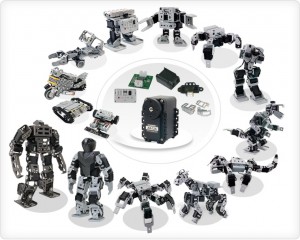There’s no denying the robotics movement is taking over STEM education. It’s even become an officially recognized high school sport in two states, with more states set to follow!
While robotics programs can vary in size and complexity, we’re seeing an increased interest from teachers in starting a robotics club at their schools.
This can be a pretty significant time commitment and there is no single rule book on how to get started, but we’ve got some tips and resources for getting your club underway.
-
Consider the grade level of your students.
It’s important to select the right instruction for the grade level you’re teaching.
At the elementary school level, teaching robotics can start with simpler concepts like the scientific principles of distance, speed, pulleys, inertia and elasticity. A great place to start is with beginner robotics kits that come with everything ready to be assembled and include multi-week curriculum to help you walk students through each lesson.
Middle school and high school students can work on more complex robotics projects that include motors, sensors, controllers and programming. This is also the level at which you can consider getting involved in competitions. Organizations like US FIRST, SAE International and the Association for Unmanned Vehicles Systems International (AUVSI) Foundation host regular competitions that students can compete in at all levels – and the entries students come up with are impressive.
Use engaging lessons plans.
Finding the right lessons plans or projects isn’t always easy. You’ll want to find something that engages students while teaching them valuable design and engineering principles. Here are a few good options:
- NASA Mars Education Lessons – From Arizona State University, these lessons have a heavy STEM focus.
- NASA’s Make Your Own Rover Lesson Plan – Geared toward elementary and middle school students, this is a set of 11 activities about Mars, rovers, and planetary.
- SOLIDWORKS Curriculum – From gears and pulleys to designing a car, SOLIDWORKS’ curriculum spans across all grade levels to help students design projects perfect for a robotics club.
- Robotics Academy – A comprehensive curriculum hosted by Carnegie Mellon University, this covers all things robotics.
Whatever you go with, most robotics projects can be really rewarding. Here’s a cool color sensor project by the folks at Robotis. It’s simple in design and the final result is simply fun for students to see in action.
Provide leadership opportunities for students.
Whether your club is big or small, it’s important to offer club members an opportunity to serve in leadership roles, like Team Captain, Engineering Manager or Team Coach. Assigning members these types of jobs is not only good for productivity, but also allows them to tap into their strengths as leaders and further develop their leadership skills.
Ask your community for advice and support.
If you find yourself strapped for time, resources or ideas, look to your community for help.
On a panel at this week’s SXSW Education Conference, educators weighed in to say that most of what they know about teaching, they learn by connecting and sharing information with other teachers online.
There are tons of forums focused on robotics and teaching, like TeacherFocus and RoboEducators. Not to mention the many Twitter chats where educators gather to share ideas, including national chats like #edtechchat and #21stedchat or local chats like #mdedchat and #vachat.
Enlisting help isn’t always done online. Are you having trouble growing your robotics club? Ask your colleagues to help advertise the club in their classes. Do you need extra hands-on support during competitions? Ask for support from your local PTA/PTO – or reach out to parents and ask for volunteer hours. You might find people are more willing to help than you’d think.
Have fun!
The best part about robotics is that it creates opportunities for celebration! Yes, there is design, engineering and problem solving involved, but solving these problems and creating awesome robots that you can see in action is exciting.
Students aren’t reading through textbooks – they are engaging in hands-on, critical thinking activities that have rewarding results.
Have you started your own robotics club? Tell us what you found to be successful.

One Comment